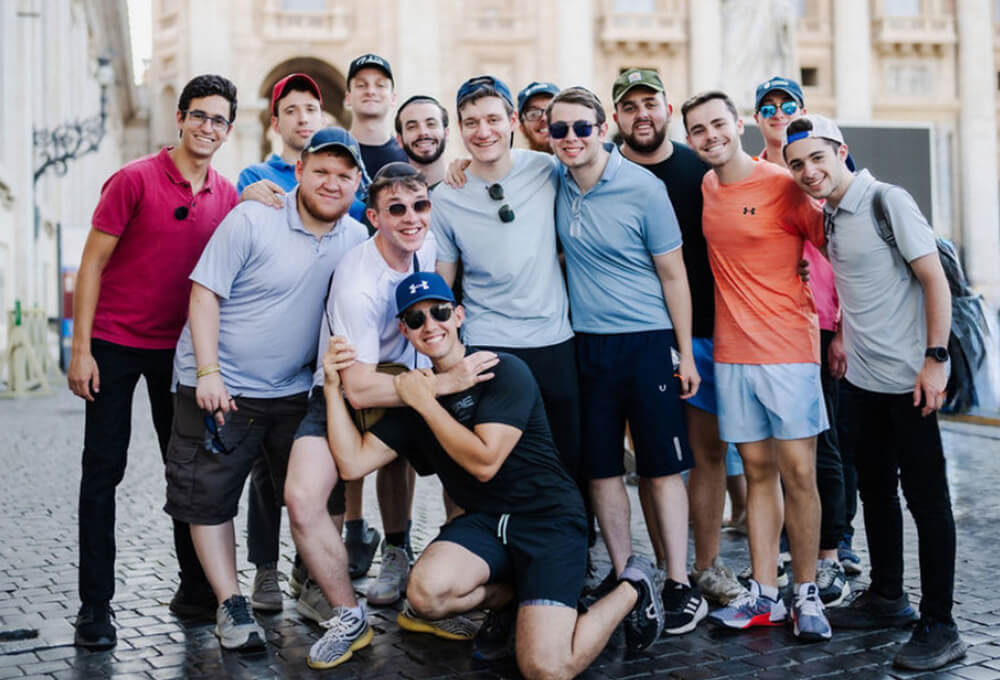Exploring Jewish History and Heritage in Rome
Reflecting on Touro’s Summer Program Blending Torah Study with Travel

Mordechai Cywiak '27 shares his experience visiting Rome on a Lander College for Men summer program for students.
This summer I had the incredible opportunity to join a group of 25 students on Touro University’s summer session 2025 in Rome, a two-week experience that blended serious Torah learning with unforgettable visits to some of the world’s most historic Jewish sites. What started as a chance to travel abroad while earning college credits quickly became a meaningful guided journey and discovery about Jewish history and faith, juxtaposed against the backdrop of ancient Rome.
Each morning, we gathered for shiurim and lectures presented by Dr. Israel Singer, Touro’s vice president of international affairs, and Rabbi Dr. Stanley Boylan, Touro’s vice president of undergraduate education and dean of faculties. They covered difficult historical chapters throughout the centuries, exploring Jewish life in Italy and culminating with the Holocaust. They focused on how Jews survived those dark times, inspiring us with stories of hope. We learned how the Italian Jews had undertaken to translate the Talmud into Italian for ease of learning, and how Jewish traditions were prevalent in the local Jewish communities and continue to evolve today.
We also learned about Jewish life in Italy during the rule of The Roman Empire from Dr. Karen Sutton, the director of the Honors Program at Lander College for Women. These were more than just lectures from members of Touro’s faculty; they were springboards to conversations among the participants that made history and Jewish faith feel alive and relevant to our current times. We were also honored to hear from Dr. Alan Kadish, president of Touro University, who joined us and brought us up to date on antisemitism on American college campuses.
From the Depths of the Ghetto to the Great Synagogue
When we left our hotel, we were excited to step into the vibrant streets of Rome, filled with Italian culture, and be alongside both Roman and Jewish history. We spent time at the Arch of Titus, a testament to the exile of the Jews after the capture of Jerusalem and destruction of the Second Temple (70 CE), and explored the former Jewish Ghetto (1555-1870), where Jews were confined to work and live within the walled area under papal mandate.
We also had the opportunity to see the growth and rise of the local Jewish community, with the beautifully designed Tempio Maggiore di Roma, the Great Synagogue of Rome. The largest synagogue in Rome, it was built shortly after the ghetto was disbanded along the banks of the Tiber River and inaugurated in 1904. Even in a city known for notable buildings and structures, Tempio Maggiore stands out, a living example of the Jewish people’s fortitude where the Jews of Rome openly pray to this day.
Ancient Roots and Modern Reflections
A theme of resilience and survival wove its way through each stop on our journey. One particularly moving day we visited the archeological site of the port city of Ostia, where the ancient Sinagoga di Ostia Antica, the Ostia Synagogue, was discovered, showcasing elements of Jewish prayer and community life from when it stood between the first and fifth centuries. While in Ostia we were privileged to see another ancient religious site, a 1,600-year-old mikvah, unearthed this past March. Each stop we made was a reminder that we are but one link in a long chain of Jewish life.
While the schedule was full, there was still time to soak in Rome’s vibrant atmosphere. We biked through Villa Borghese, enjoyed a boat ride on the Tiber River, and spent a sunny afternoon at a vineyard south of Rome. These moments gave us time to relax, reflect, get to know each other and connect our learning to the world around us.
Rest, Reflection and Resilience
Shabbos in Rome was one of the highlights of the trip. Beyond the tefillah, Shabbos meals and opportunity to relax, we also kept up our Jewish learning with a shiur from our trip-planner extraordinaire, Rabbi Menachem Lazar, and another by Esther Boylan, a professor of Jewish Studies at Lander College for Women. Professor Boylan reminded us of the strength woven into our Jewish identity, a particularly poignant lesson for the Jewish leaders of tomorrow in the face of rising antisemitism throughout the world. (Notably, while we felt safe as Jewish travelers, we were accompanied by a security detail for the entirety of the trip!)
In the final days of our trip, we visited the Jewish Catacombs of Torlonia, an ancient underground cemetery, and enjoyed a lecture by Herb Ratner, associate dean for administration and advisement for Lander College for Men, who discussed the life of Primo Levi, a Jewish Italian chemist (1919-1987), partisan, Holocaust survivor and writer. Both of these experiences added important pieces of history to our experience, as many of us, including myself, are the great-grandchildren of Holocaust survivors. We walked, learned and reflected, each step deepening our understanding and connection to each other, to Torah, to past Jewish life and to our Jewish faith. The entire trip was organized by Rabbi Dr. Simcha Fishbane, Touro's vice president and liaison for European programs, to whom we are grateful.
This was not my first visit to Rome, but with the focus of our dedicated professors and their lectures and insight bringing all the locations we visited to life, I returned home with a renewed spirit and a deeper appreciation for our shared history. It was more than just a tour; it was a journey into the heart of Jewish life, both past and present, and a lesson to help guide us toward our future.

